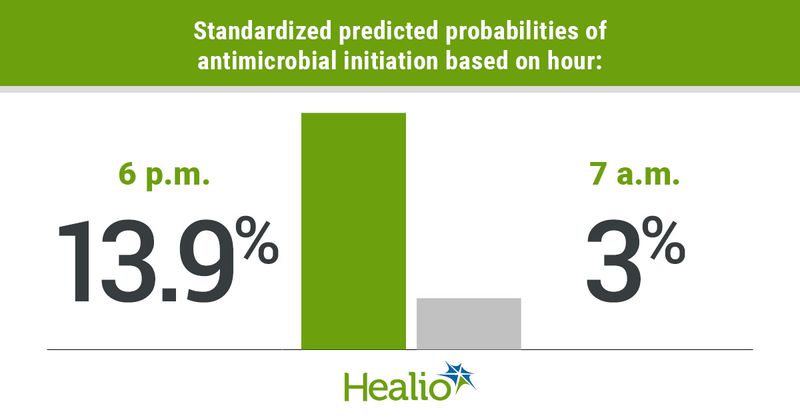Low likelihood of antimicrobials for sepsis during shift changes, night shifts
Key takeaways:
- During shift changes at 7 a.m. and 7 p.m., there was a low likelihood of receiving antimicrobials for sepsis.
- Developing sepsis during night shift hours meant a longer time to antimicrobial initiation.
During hours of the day signaling shift changes and night shifts, the likelihood of starting antimicrobials for hospital-onset sepsis was reduced, according to study results published in Annals of the American Thoracic Society.
“Antimicrobial initiation among ward patients with hospital-onset sepsis was less likely at shift change and during the night compared with the day shift and was increasingly delayed as the night shift progressed,” Jennifer C. Ginestra, MD, MSHP, fellow in the division of pulmonary, allergy and critical care at the Hospital of the University of Pennsylvania, and colleagues wrote.

In a retrospective cohort study, Ginestra and colleagues analyzed 1,672 patients with hospital-onset sepsis from five acute care hospitals to find out how time of day is linked to antimicrobial initiation through a discrete-time time-to-event model.
Time passed from sepsis onset was accounted for in this model.
Between admission and sepsis onset, a median of 7.3 days passed, according to researchers.
During a 24-hour day, researchers found different standardized predicted probabilities of antimicrobial initiation based on the hour. At 6 p.m., the likelihood of initiation was high (13.9%; 95% CI, 11.3%-16.5%), whereas the likelihood at 7 a.m. (3%; 95% CI, 1.8%-4.1%) was low.
Probabilities at 7 a.m. and 7 p.m. (shift changes) marked the lowest points, but at 9 a.m. and 9 p.m., researchers observed peaks.
Looking at the hours comprised in a night shift (7 p.m.-7 a.m.), the probability of antimicrobial initiation was on the higher side at 9 p.m. at 13.4% (95% CI, 10.7%-16%) but dropped to 3.2% (95% CI, 2%-4%) by 6 a.m.
Researchers also evaluated how time of day of sepsis onset was related to time to antimicrobial initiation using a quantile regression model and found a longer standardized predicted median time to treatment if onset occurred during night shift hours (12.9 hours; interquartile range [IQR], 10.9-14.9 hours) vs. day shift hours (3.2 hours; IQR, 2.5-3.8 hours).
When assessing individual hours, the longest standardized predicted median time to initiation was found when sepsis onset occurred at 6 a.m. (33.2 hours; 95% CI, 27.2-39.2 hours), whereas the shortest time was found when patients had sepsis onset at 9 p.m. (1.3 hours; 95% CI, 0.6-2.1 hours).
Researchers further found a low adjusted probability of antimicrobial initiation within 3 hours of sepsis onset when the condition appeared at 6 a.m. (13.3%; 95% CI, 6.6%-20.1%). In contrast, this adjusted likelihood was high if patients developed sepsis at 2 p.m. (72.4%; 95% CI, 61.9%-83%).
Developing sepsis between 9 p.m. and 12 a.m., as well as in the latest hours of night shift meant a reduced standardized predicted probability of antimicrobial initiation within 1 and 3 hours of sepsis onset, according to researchers.
Notably, no link was found between hours that had longer times to start antimicrobials and higher rates of in-hospital mortality.
“Between-shift handoff processes, staffing patterns and/or decision fatigue may contribute to delays in treatment for ward patients with hospital-onset sepsis,” Ginestra and colleagues wrote. “Future work should validate these findings in other settings and distinguish between potential mechanisms to inform quality-enhancing interventions.”
Based on findings from this study, some changes are necessary in sepsis care, according to an accompanying editorial by Patrick G. Lyons, MD, MSc, assistant professor of medicine at Oregon Health & Science University, and Catherine L. Hough, MD, MSc, chair of the department of medicine at Oregon Health & Science University.
In addition to the need for better markers that correctly and promptly identify sepsis, Lyons and Hough wrote that those in critical care must consider how their work schedules impact patients.
“These findings add a temporal dimension to already recognized domains of sepsis care variation; in doing so, they reveal a disconnect between many patients’ illnesses trajectories and typical schedules on the wards,” Lyons and Hough wrote. “Therefore, there is a need for system-level interventions to recognize and respond to sepsis more consistently at particular times of the day.”
